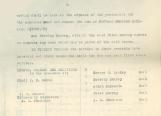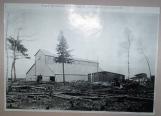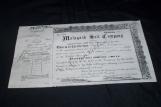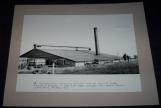14
Agreement between the mine founders and the land owners29 June 1917
Malagash, Nova Scotia, Canada

15
Agreement between the mine founders and the land owners29 June 1917
Malagash, Nova Scotia, Canada

16
This three page agreement dated 29th, June 1917, between Peter Murray, Alan McKenzie (farmers), George MacKay and A. R. Chambers; said that MacKay and Chambers could carry out prospecting on their farm property to further investigate the salt deposits.17
Interview with Isabell (Murray) McNeil daughter of Peter MurrayJuly 2005
Malagash, Nova Scotia, Canada

18
Transcription of an Interview with Isabel (Murray) McNeilGood morning. I'm interviewing Isabell McNeil of Malagash. Good morning Isabell.
Good morning.
I wonder if you could please tell me your full name, and where you were born?
Well as far as I know I was born in Malagash. Isabell Murray McNeil or Isabell Christina Murray McNeil.
And what year were you born?
1911.
And what your parents names?
My father was Peter William Murray. My mother was Dorothy Jessie Sutherland.
And what did your parents do for a living?
My father was a farmer and my mother had been a school teacher.
Now when your dad was farming, I know there's a lot of salt in this area, did the salt ever affect the farming at all?
Oh mercy no! He discovered the salt mine, but he discovered that because he had hired a man to bore a well because in those days the only wells they had on the farm over there when he bought it were a dug well. There was a dug well out between the house and the road, where we got our drinking water; and there was a dug well, another dug well at the end of the barn, they watered the cattle. And on dry years when there wasn't a lot of water, the wells would go dry, especially the barn well, would go dry. So they hired a man to come to bore a well near the barn for the cattle. So he did and got a good of flow of water for the cattle and that's where they struck the salt, while he was boring the well there.
So what did he do about it when they struck salt?
Well they didn't do, he didn't do too much about it. He er.. in those days they didn't know anything about it except it was salt water. They didn't even why the water was so salt. But the man come and bored wells at different places on the farm, and they bored them in twenty some places and they got salt in most places. And there was one well right across the road from the farm that they put a pump on, and I remember they used to hang a little tin mug hanging on the pump so the people coming along, going along the road, would stop and try a drink and have a drink of the stuff and test it. Actually when it was tested it was 98% salt.
In what year did it finally become a salt mine in this area?
Well it was about 1917, 1918, that they got the people interested in New Glasgow, the Department of Mines, I suppose. Chambers and MacKay. Mr. MacKay people called it around here but he called it MacKay, the Scottish way of saying it I guess. He was a man of, I don't why, but he was a wealthy man and Chambers was a man was interested in it and had the education to know about the mine. And between the two of them they got the mine started about 1917, 1918.
So do you remember that when the mine first started?
Oh yes, I remember that.
And was it on your dad's land?
Just where the line fence where he and the next property, and the next property was owned by a Mrs. McKenzie, and there were no buildings on it. It was just a piece of land that she owned. And so the shaft, or the hole into the mine; my dad for some reason or other, didn't want it to go down on his property because it meant that the dump, of where they dumped all of the stuff that took out of the hole, he didn't want that on his property. It went the other way onto the other. So they bought a piece of property from the other lady, and that's where they made the shaft, joining the fence.
20
THE HISTORY OF THE SALT MINE IN MALAGASHIn 1924 when the partnership of Chambers and MacKay was dissolved as such, they formed Malagash Salt Products Ltd. In 1927 the firm was re-organized as the Malagash Salt Company Ltd., with an authorized capital of 10,000 no par value common shares. It was at this time that the Imperial Chemical Corporation of Great Britain invested $50,000 into the venture in an endeavour to find a workable deposit of potash, which was unfulfilled.
Malagash Salt affords a case history of success attained through perseverance. Deficit followed deficit, and 22 years were to pass before the directors had the gratification of issuing a statement to shareholders that showed a reasonable profit. At one stage of the company's operation, a majority of the directors wanted to cease operating and wind up the company. MacKay and Chambers held out to continue, and personally borrowed $50,000 from the Bank of Nova Scotia to purchase an equivalent sum to face value of Malagash Salt Bonds.
In the early thirty's the company was often without funds to meet its payroll of over 80 men plus office staff.
22
MORE SALT MINE HISTORYWhen the operation was re-organized in 1948 as the Malagash Salt Company, J. L. Cavanaugh, who had been actively associated with the enterprise from the earliest days acting as mine manager, became president, with George MacKay as a director. The mine was producing from 50,000 to 60,000 tons of salt annually, and had its own 10 mile railway, with the salt hauled out by diesel locomotives. The company also had shipping facitlities on Tatamagouche Bay, near the mine site, with a warehouse having a capacity of over 10,000 tons. Here vessels up to 3,500 tons could be accomodated.
24
SUCCESS AT LASTThe company was reorganized in 1948. Control of the company left New Glasgow in 1951, when the Canadian Salt Company bought, on the open market, all of the common stock. The new owners continued to operate Malagash Salt Company Ltd., as a subsidiary and paid its preferred stock interest regularly.
The deposit at Malagash being nearly exhausted, a new mine was laid out at Pugwash, and shaft sinking began in 1954. The old mine after 41 years and a production of approximately 2 million tons, was abandoned in March, 1959. The new mine at Pugwash went into production in the fall of 1959.
26
THE FIRST MILL WAS DESTROYED BY FIRE JULY 28,1923.Seven men were in the mine as fire started in the mill just after lunch.
William Canfield, Cecil Hartling and George Jewers, recall that foreman Alex Gullens had gone into the mine with seven miners after lunch.
The fire, which started from the diesel engine which ran the hoist or mill (there were two engines) raged for hours and consumed the mill and headframe. Each time the miners climbed up the shaft they were forced to return to the bottom 110 feet below. They soaked jute bags in water found in a sump and built a brattice with wet sacks sewn together with nails, as well as using a wet bag over the face as a filter, or gas mask.
Cecil Hartling estimates they waited about two hours before the fire spent itself out and they were able to climb out. Men on the Surface were throwing buckets of water into the shaft, and the falling water brought welcome fresh air with it.
A close call but all came through it apparently none the worse.




